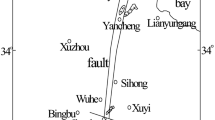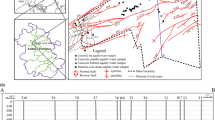Abstract
Hydrochemistry of groundwater is important for inrush water source identification in coal mines. For determining the source of inrush water from the 8101 working face in the Wolonghu coal mine, Northern Anhui Province, China, a total of 22 groundwater samples from three aquifer systems (loose layer—LA, coal bearing sandstone—CA, and the underlying limestone—TA), and eight samples from the 8101 working face were collected for analyzing major ion concentrations. The results suggest that major ion concentrations of the aquifer systems were different from each other, and they can be subdivided into Na–HCO3, Na–SO4, and Ca–SO4 types. Factor analysis indicates that their chemical compositions are mainly originated from two kinds of contributions: dissolution of soluble minerals (e.g., calcite, dolomite, and gypsum) and weathering of silicate minerals (e.g., plagioclase). Plots of factor scores and cluster analysis imply that LA was connected with CA, whereas TA was an isolated aquifer system. Moreover, the source of 8101 working face water was finally determined to be LA by using discriminant analysis.







Similar content being viewed by others
References
Alpers CN, Nordstrom DK (1999) In: Plumlee GS, Logsdon MJ (eds) Geochemical modeling of water–rock interactions in mining environments. In Reviews in Economic Geology, The Environmental Geochemistry of Mineral Deposits Part A Processes, Methods and Health Issues, vol. 6A, 289–324.
Chen MZ, Zhou GQ (2012) Coal mine flood accident analysis and preventing and controlling technology research. W China Explor Eng 3:201–204 (in Chinese)
Gui HR (2012) Chemistry of groundwater from sandstone aquifer in Wolonghu coal mine, northern Anhui Province, China. Adv Mater Res 599:697–700
Gui HR, Chen LW (2007) Hydrogeochemistric evolution and discrimination of groundwater in mining district. Geological Publishing House, Beijing, pp 32–44 (in Chinese)
Kimball BA, Runkel RL (2009) Spatially detailed quantification of metal loading for decision making: metal mass loading to American Fork and Mary Ellen Gulch, Utah. Mine Water Environ 28(4):274–290
Lu JT, Li XB, Gong FQ, Wang XR, Liu J (2012) Recognizing of mine water inrush sources based on principal components analysis and fisher discrimination analysis method. China Saf Sci J 22(7):109–115 (in Chinese)
Pirc S, Uhan J (1991) Application of hydrochemistry for prediction water irruptions in Zasavje Collieries. Proc 4th Int Mine Water Assoc Congr 1:279–289
Qian JZ, Lv C, Zhao WD, Pan Q (2010) Comparison of application on Elman and BP neural networks in discriminating water bursting source of coal mine. Syst Eng Theory Pract 30(1):145–150 (in Chinese)
Qin SB, Ouyang ZP, Cheng TS (2008) Application of hydrochemistry classifying with hierarchical cluster analysis. Ground Water 30(1):21–24 (in Chinese)
Rapantova N, Krzeszowski S, Grmela A, Wolkersdorfer C (2012) Quantitative assessment of mine water sources based on the general mixing equation and multivariate statistics. Mine Water Environ 31(4):252–265
Stetzenbach KJ, Hodge VF, Guo C, Farnham IM, Johannesson KH (2001) Geochemical and statistical evidence of deep carbonate groundwater within overlying volcanic rock aquifer/aquitards of southern Nevada, USA. J Hydrol 243:254–271
Sun LH, Gui HR (2012) Establishment of water source discrimination model in coal mine by using hydrogeochemistry and statistical analysis: a case study from Renlou Coal Mine in northern Anhui Province, China. J Coal Sci Eng (China) 18(4):385–389
Tang YW (2008) Research on China’s coal consumption and pricing system. Resour Sci 30(4):554–559 (in Chinese)
Toth J (1999) Groundwater as a geologic agent: an overview of the cause, processes and manifestations. Hydrogeol J 7:1–14
Veselič M, Mali N (1991) Reliability of hydrogeochemical methods as water inrush risk prediction tools. Proc 4th Int Mine Water Assoc Congr 1:313–326
Worrall F, Pearson DG (2001) Water–rock interaction in an acidic mine discharge as indicated by rare earth element patterns. Geochim Cosmochim Acta 65(18):3027–3040
Yan ZC, Liu GJ, Sun RY, Tang Q, Wu D, Wu B, Zhou CC (2012) Geochemistry of rare earth elements in groundwater from the Taiyuan Formation limestone aquifer in the Wolonghu Coal Mine, Anhui province, China. Journal of Geochemical Exploration. doi:10.1016/j.gexplo.2012.11.011
Acknowledgment
Thanks very much to an anonymous reviewer for his valuable comments. This work was financially supported by the National Natural Science Foundation of China (41173106), the Natural Science Foundation of Anhui Province (1308085QE77), and the Program for Innovative Research Team in Suzhou University (2013kytd01).
Author information
Authors and Affiliations
Corresponding author
Rights and permissions
About this article
Cite this article
Sun, L.H. Statistical analysis of hydrochemistry of groundwater and its implications for water source identification: a case study. Arab J Geosci 7, 3417–3425 (2014). https://doi.org/10.1007/s12517-013-1061-8
Received:
Accepted:
Published:
Issue Date:
DOI: https://doi.org/10.1007/s12517-013-1061-8




